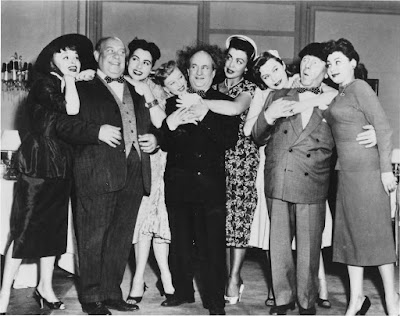 |
| French film poster for the 1966 film version of Batman. |
 |
| From L to R: Catwoman (Lee Meriwhether), The Riddler (Frank Gorshin), The Penguin (Burgess Meredith) and The Joker (Cesar Romero). |

 |
| French film poster for the 1966 film version of Batman. |
 |
| From L to R: Catwoman (Lee Meriwhether), The Riddler (Frank Gorshin), The Penguin (Burgess Meredith) and The Joker (Cesar Romero). |
Posted by secretbasementlab at 12:16 PM 3 comments
Labels: adam west, Batman, mid-week movie break, movies
 |
| Renzo and Mary-Belle smooch, unaware of the creature waiting to strike. |
 The film was made in 1958, but was released in 1961 when sold to Roger Corman’s Filmgroup Releasing company. It was put on a double bill with, you guessed it, Creature From The Haunted Sea. Devil’s Partner was directed by Charles R. Rondeau who directed numerous episodes of some of the greatest television shows in tv history, including Batman, Mission: Impossible, The Wild Wild West, Surfside 6 and more. The amazing soundtrack here is composed by frequent Corman collaborator Ronald Stein, and the great news is the tunes are now available to purchase and download through various digital music channels. Take a listen here.
The film was made in 1958, but was released in 1961 when sold to Roger Corman’s Filmgroup Releasing company. It was put on a double bill with, you guessed it, Creature From The Haunted Sea. Devil’s Partner was directed by Charles R. Rondeau who directed numerous episodes of some of the greatest television shows in tv history, including Batman, Mission: Impossible, The Wild Wild West, Surfside 6 and more. The amazing soundtrack here is composed by frequent Corman collaborator Ronald Stein, and the great news is the tunes are now available to purchase and download through various digital music channels. Take a listen here.Posted by secretbasementlab at 10:45 AM 0 comments
Labels: b-movie, creature from the haunted sea, devil's partner, drive-in, film, mid-week movie break, monster movies, Roger Corman
 |
| Disturbing hand puppet. |
 |
| "He'll never make it through this intense bombardment. Nobody could." Michael Nesmith warning the viewers what they're in for in Head. |
Posted by secretbasementlab at 9:50 AM 2 comments
Labels: head, mid-week movie break, Monkees, The Monkees
 |
| Screen grab showcasing some of the oddball club interiors seen in the film. |
 |
| Akira Kobayashi 45 on Colombia |
 |
| The Black Tight Killers in a masked go-go dance frenzy |
 |
| Note the Goldfinger-esque gold-painted dancers. This is a plot point in how the crooks intend to do away with Yuriko. |
 |
| Chieko Matsubara 45 for Colombia Records. |
 |
| George Douglas as Sheriff Dubbitt (right) in Attack Of The 50 Foot Woman |
 |
| Monte 'Alamo' Rawlins (left) and Tooney (Art Davis, billed as Larry Mason) with Boots the Wonder Dog, who's just retrieved the Phantom's knife. |
 |
| Betty Burgess - photo from Univ. of Washington archives. |
Posted by secretbasementlab at 8:03 AM 0 comments
Labels: b-movie, cinema, Country, cowboy, film, Masked Phantom, mid-week movie break, movie, western
 |
| A page from issue 18 of The Monster Times, spotlighting TMOPB. |
 |
| The opening shot to the Flipper episode "Flipper's Monster". |
 |
| Jeanne Carmen in a publicity still from The Three Stooges short A Merry Mix-Up. Carmen is third from the left, cuddling up to Joe Besser. |
 The picture was produced by Jack Kevan and production partner Irvin Berwick, a one-time dialog editor for Columbia who had worked with William Castle and Jack Arnold, so he was already entrenched in the ways of the low budget sci-fi/horror/monster movie. Tired of working in obscurity in largely thankless and uncredited roles for the studios, Kevan and Berwick decided to try their hand at becoming independent producers, hence Vanwick Productions. The picture was made for around $29,000 with a number of favors and at-cost help being utilized from Kevan’s old connections at Universal. To my knowledge the only other picture Vanwick Productions ever had a hand in producing is a seedy 1966 drama called The Street Is My Beat, filmed in Texas. Kevan and Berwick did work together again however on pictures like Crown International’s The 7th Commandment (1961).
The picture was produced by Jack Kevan and production partner Irvin Berwick, a one-time dialog editor for Columbia who had worked with William Castle and Jack Arnold, so he was already entrenched in the ways of the low budget sci-fi/horror/monster movie. Tired of working in obscurity in largely thankless and uncredited roles for the studios, Kevan and Berwick decided to try their hand at becoming independent producers, hence Vanwick Productions. The picture was made for around $29,000 with a number of favors and at-cost help being utilized from Kevan’s old connections at Universal. To my knowledge the only other picture Vanwick Productions ever had a hand in producing is a seedy 1966 drama called The Street Is My Beat, filmed in Texas. Kevan and Berwick did work together again however on pictures like Crown International’s The 7th Commandment (1961). |
| Don Sullivan on his book The Perfect Look: Don Sullivan's Hair Care Secrets |
 |
| Honolulu Star Bulletin article highlighting the career of Jack Kevan. |
 |
| Packaging of the Super 8 home movie version of The Monster of Piedras Blancas. |
Posted by secretbasementlab at 8:57 AM 1 comments
Labels: film, mid-week movie break, monster movies, Monsters, movies
 |
| Margaret Hamilton as witch Aunt Huddy in Comin' Round The Mountain |
 |
| Poster for a double bill of Comin' Round The Mountain paired with the 1948 Marjorie Main, Percy Kilbride (not as Ma & Pa Kettle) film Feudin', Fussin' and A-Fightin'. |
Posted by secretbasementlab at 12:58 AM 1 comments
Labels: Comedy, film, mid-week movie break, movies